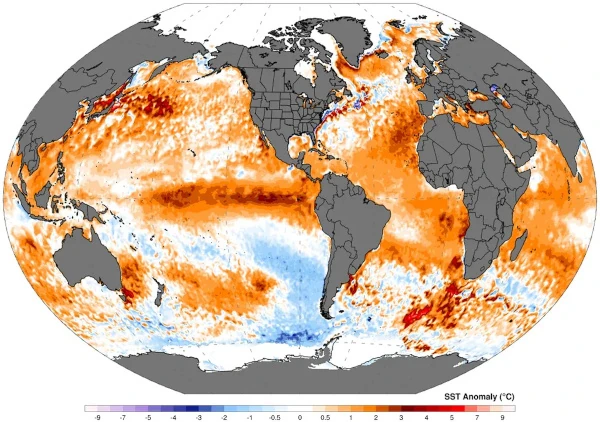
Description of the image: The consequences of the El Niño phenomenon are the warming of the ocean surface and changes in atmospheric circulation. National Centers for Environmental Prediction, US. (Public domain).
El Niño and La Niña are opposite phases of the El Niño-Southern Oscillation (ENSO) cycle, a recurring climatic phenomenon that has significant impacts on the global climate. This cycle is characterized by variations in sea surface temperature in the equatorial Pacific, influencing weather and climatic conditions around the globe.
El Niño manifests as an abnormal warming of the surface waters of the central and eastern Pacific Ocean. This phenomenon occurs every 2 to 7 years and generally lasts 9 to 12 months.
The consequences of this phenomenon are the warming of the ocean surface and changes in atmospheric circulation. Indeed, a decrease in trade winds (east-west winds) leads to a weakening of the equatorial current, allowing warm waters to accumulate in the eastern Pacific. Additionally, the accumulated heat in the eastern Pacific modifies atmospheric convection patterns, shifting precipitation zones and influencing global weather systems.
The warming of the ocean further reduces the trade winds, thus amplifying the phenomenon.
La Niña is the opposite of El Niño and is characterized by an abnormal cooling of the surface waters of the central and eastern Pacific Ocean. It occurs with a frequency similar to that of El Niño but tends to last longer, often 1 to 2 years.
The consequences of this phenomenon include the strengthening of trade winds. Indeed, the east-west winds strengthen, increasing the transport of warm waters towards the western Pacific and bringing cold waters up from the depths in the east. Additionally, the increase in cold water upwelling in the eastern Pacific leads to a drop in surface temperatures.
The cooling of the surface reinforces the trade winds, amplifying the La Niña phenomenon.
El Niño has climatic effects on South America. The consequences are intense rains and floods on the west coast, particularly in Peru and Ecuador.
In North America, winters are milder and wetter in the southern United States, and droughts are observed in the Pacific Northwest.
In Southeast Asia and Australia, droughts are more severe and the risk of forest fires is increased.
In Africa, some regions, particularly in southern and eastern Africa, are drier.
La Niña also alters the climate in South America. On the west coast, regions are drier.
In North America, winters are colder and wetter in the northwestern United States, and drier conditions are observed in the south.
In Southeast Asia and Australia, rains are more abundant, increasing the risk of floods.
In Africa, conditions are wetter in some regions, such as eastern Africa.
El Niño contributes to a rise in global temperatures by +0.2° to 1° (as in 2023), which exacerbates heatwaves and thermal anomalies in various regions of the world.
The El Niño phenomenon has major climatic and socio-economic impacts on a global scale. These impacts vary depending on the intensity of the phenomenon and the vulnerability of the affected regions.
El Niño changes rainfall patterns, leading to torrential rains along the west coast of South America, particularly in Peru and Ecuador. These intense precipitations cause devastating floods, landslides, and significant infrastructure damage.
El Niño is often associated with severe droughts in Australia and Indonesia, leading to water shortages, crop losses, and an increased risk of forest fires.
Southern Africa and India experience periods of drought, affecting water supply and agricultural yields.
El Niño 1997-1998 was the strongest of the 20th century. It caused droughts in Indonesia and Papua New Guinea, forest fires in the Amazon, and floods in South America and East Africa. It is estimated that this event caused economic damage amounting to $36 billion.
El Niño 1982-1983 caused devastating droughts in Australia and southern Africa, as well as floods in South America and California. It is estimated that this event caused economic damage amounting to $20 billion.
El Niño 2015-2016 caused droughts in Ethiopia and Somalia, floods in South America and China, and massive coral bleaching in the Great Barrier Reef. It is estimated that this event caused economic damage amounting to $2 billion.